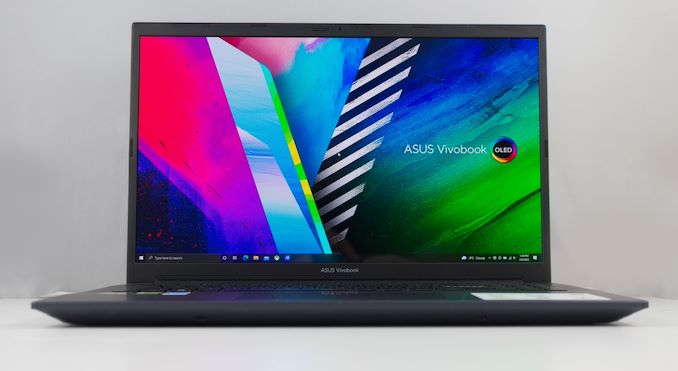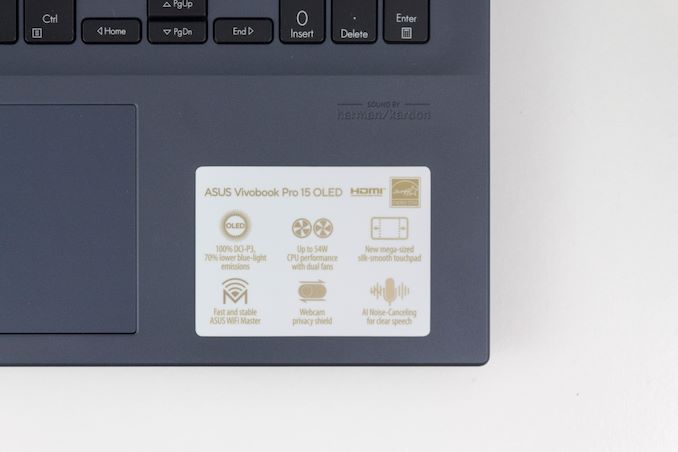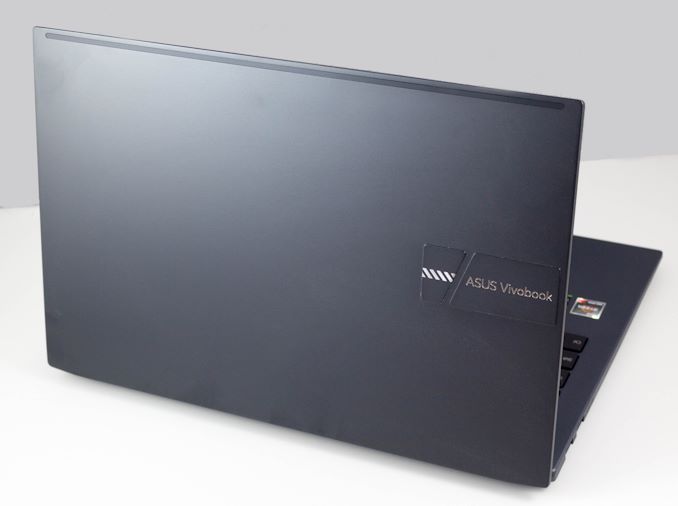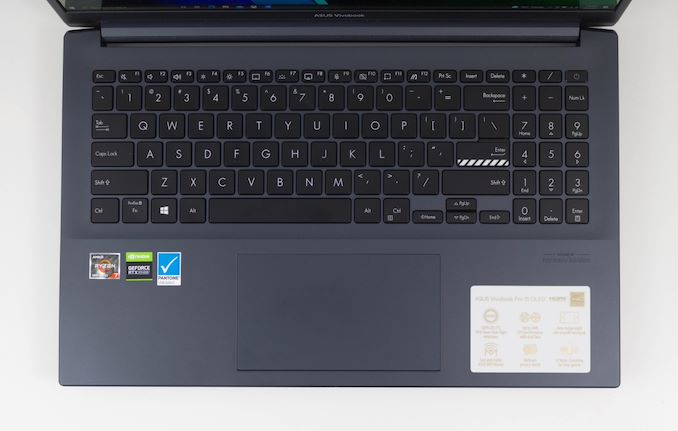The ASUS Vivobook Pro 15 OLED Review: For The Creator In All Of Us
by Brett Howse on March 7, 2022 8:30 AM EST
As the market for notebook computers has expanded, new product categories have been developed to fill the needs of a wider range of audiences, and one area that has been rapidly expanded in recent years is the Content Creator notebook. Demanding more performance than a typical thin and light notebook can provide, the creator notebooks fill a gap between gaming and light use, featuring extra graphics performance and CPU performance, while generally offering a subdued yet stylish form factor that still allows for portability.
ASUS has been building notebooks for this market for several years now, and today we are looking at the Vivobook Pro 15 OLED. The name kind of gives away the special feature of this device but including a 15.6-inch OLED display adds a major punch to the offering. Although OLED has not taken over the PC industry like it has the smartphone world, there is really nothing like the stunning contrast ratio OLED provides, as well as the wider color gamut most OLED devices support. In the case of the Vivobook Pro 15, that means 100% full coverage P3 gamut support.
ASUS provides both AMD and Intel versions of the Vivobook Pro, and the M3500 they have supplied us features the Ryzen 5000 Mobile series processors coupled with NVIDIA RTX Studio graphics. It ships with 16 GB of DDR4 RAM and 512 GB of SSD storage. Offering both AMD and Intel options is most certainly a nice feature. ASUS shipped this to us prior to the Ryzen 6000 launch and provided the Ryzen 7 5800H variant.
| ASUS Vivobook Pro 15 OLED | |||||
| Component | Ryzen 5 | Ryzen 7 Model Tested |
|||
| CPU | AMD Ryzen 5 5600H 6-core / 12-thread 19MB Cache 4.2 GHz max boost 45W TDP |
AMD Ryzen 7 5800H 8-core / 16-thread 24MB Cache 4.4 GHz max boost 45W TDP |
|||
| GPU | NVIDIA RTX 3050 Laptop Max-Q 2048 CUDA Cores 4GB GDDR6 128-bit |
||||
| RAM | 16GB DDR4 Soldered |
||||
| Storage | 512GB PCIe 3.0 SSD | ||||
| Display | 15.6-inch 1920x1080 OLED 100% P3 D65 Gamut PANTONE Validated 84% Screen-to-body ratio Glossy No Touch |
||||
| I/O | Left Side: 2 x USB 2.0 Type-A Right Side: 1 x USB 3.2 Gen 1 Type-A 1 x USB 3.2 Gen 1 Type-C 1 x HDMI 1.4 1 x 3.5mm headset Micro SD Power connector |
||||
| Networking | Wi-Fi 5 Intel 8265 Wireless NIC Bluetooth 4.2 Optional Wi-Fi 6 on some models |
||||
| A/V | Harmon Kardon speakers 720p webcam with privacy shutter |
||||
| Battery | 63 Wh Battery 120W AC Adapter |
||||
| Dimensions | 360 x 235 x 18.9 mm 14.17 x 9.26 x 0.74 inches |
||||
| Weight | 1.65 kg / 3.64 lbs | ||||
| Price (USD) | $920 | $1,099.99 | |||
There’s a reasonable amount of expandability of the device, which offers two USB 2.0 Type-A ports, a single USB 3.2 Gen 1 Type-A port, and a single USB 3.2 Gen 1 Type-C port. There is also a HDMI 1.4 connection, as well as a Micro SD card reader. For a device aimed at content creation, the port selection perhaps is not the best as a full-size SD card reader would have been preferred for offloading images from a camera, and the HDMI port rather than a DisplayPort is odd, although you can of course use an adapter from the Type-C port or HDMI to convert if needed.
ASUS offers up to Wi-Fi 6 in the Vivobook Pro 15, although the AMD review unit arrived with the Intel Wireless-AC 8265 network card which is Wi-Fi 5. It is one of the best Wi-Fi 5 devices around, thankfully.
ASUS offers the Vivobook Pro in two color choices as well. Prospective buyers can choose between Quiet Blue, which is what our review unit is, or Cool Silver.
The major feature though is definitely the OLED display. The 16:9 1920x1080 15.6-inch panel is undoubtedly the star attraction with incredibly rich blacks and vivid, punchy colors. We will of course dig into the display in more detail shortly.
ASUS packs quite a bit into the Vivobook Pro’s 1.65 kg / 3.6 lb package. Let’s dive in.
Design
The Vivobook Pro 15 OLED is a very traditional notebook design, with a 16:9 aspect ratio display that easily opens with one finger. The display back features an aluminum cladding while the main chassis of the device is polycarbonate. For the price point, ASUS has done a nice job here balancing cost versus feel, and the rigidity of the device is very solid.
The display bezels are reasonable thin, with ASUS stating the laptop offers an 84% screen to body ratio. The sides are thin and the top and bottom are wider which does help with the fitment of the webcam, although the webcam is only a 720p offering. It does offer a sliding privacy shutter which is a nice touch.
A 16:10 panel, such as the 14-inch version of this device offers, would have been a better fit with the product category as well. For content creators, having the extra vertical space on the display over a normal 16:9 panel allows for application controls while working on full-screen video.
Taking a look at the keyboard deck ASUS has fitted the Vivobook Pro 15 with a number pad to the left of the keyboard. This is always a compromise, especially on a 15-inch notebook, and does offset the keyboard to the left. ASUS was able to fit in full-size keys though and the keyboard feel is quite good. The key depressions are firm and offer a solid 1.35 mm of key travel, although they key caps themselves are flat and smooth. A bit more texture on the keys would have been nice, such as what ASUS offers on some of their ROG laptops. There is three levels of white backlighting which works well contrasting with the dark keys. ASUS does put the power button in the keyboard itself, which can cause issues accidentally pressing it, but thanks to the number pad the power button is not close to the delete key which should help.
ASUS has included an oversized touch pad in the Vivobook Pro 15 which works very well. It is incredibly smooth and responsive. It lacks some of the tactile feedback of the newer haptic touchpads but nevertheless is a good implementation. Despite the extra width, the palm rejection seems to work well as it never got in the way when typing.
The Vivobook Pro 15 offers a somewhat strange set of ports and the layout is also odd. The power connection as well as the faster USB ports are all on the right side of the notebook, which can get in the way if you were using it with a mouse and right-handed, as most people are, and the headset jack is also in the way. The power connector does offer a 90° connector which does help. Due to the 120-Watt AC Adapter, USB-C charging is not possible for maximum load, so ASUS has gone with a traditional barrel connector for power. The left side of the notebook has two USB 2.0 ports only. There is also a full-sized HDMI 1.4 port on the right side, as well as a micro SD card reader. A full-sized SD card reader would have been a better option for people wanting to pull files off a camera.
Where the Vivobook really shines though is its portability. Despite being a 15-inch notebook with a discrete GPU included, the Vivobook is still only 1.65 kg / 3.64 lbs. It is not quite a 14-inch notebook size, but the 84% screen-to-body ratio does help keep the overall dimensions in check. If you are looking for something with a proper 45-Watt processor and dedicated graphics, but still need to use it on the go, ASUS has done an excellent job on packaging.
















33 Comments
View All Comments
edechamps - Monday, March 7, 2022 - link
"Sadly, Windows does not offer great support for either HDR or wider than sRGB color spaces. There is no native color management system in Windows which will display sRGB content at the correct color levels on a wider than sRGB display, which means the colors will be over-saturated unless you are using a properly color-managed application such as Adobe Photoshop. That means most content you look at on this notebook will be the oversaturated. […] Sadly Windows still does not handle non-sRGB color gamuts very well, so even though ASUS has done a reasonable job calibrating the display, most of the time the color accuracy will be terrible unless you are using a color managed application."This is NOT correct when using Windows with HDR mode enabled. In HDR mode, Windows correctly gamut-maps sRGB from SDR apps to the absolute BT.2020 color space "container" used for HDR, transparently and in real time. Apps that want to use the extra color space are free to do so using the relevant Microsoft APIs, and they will be properly presented alongside other apps. See: https://docs.microsoft.com/en-us/windows/win32/dir...
I'm doing precisely this using Windows 11 in HDR mode with an LG OLED TV. I have personally verified using a color meter that standard sRGB apps are being gamut-mapped correctly, and the saturation is correct, with only slight errors caused by the TV's imperfect calibration.
The quote above describes a state of affairs that was certainly valid a few years ago, but it is now quite outdated.
Brett Howse - Tuesday, March 8, 2022 - link
Thanks for this info. I am going to look into this more. In HDR it does appear to tone map to sRGB by default which is certainly the less offensive implementation.Oxford Guy - Sunday, March 13, 2022 - link
Check out the tftcentral site and possibly prad.de (if that’s still around). Those sites have long had rather comprehensive information about all of the nuances involving monitors. Prad.de, for instance, was the first to write about LCD backlight flicker.lemurbutton - Monday, March 7, 2022 - link
If you’re a creator, you get a MacBook Pro with far more power and portability.TheinsanegamerN - Tuesday, March 8, 2022 - link
How is a macbook pro mroe portable then this? And it may surprise you, but not all creators are addicted to daddy Ives ruining their wallet every year.jospoortvliet - Saturday, March 12, 2022 - link
Battery life is better indeed but price is far far higher… I’d consider a MacBook Air though, for at least a subset of creator taks (audio, image and video editing) it would do great.yetanotherhuman - Tuesday, March 8, 2022 - link
Numpad to the left of the keyboard? Looks like it's on the right, as standard, to me..TheinsanegamerN - Tuesday, March 8, 2022 - link
OLED is an interesting feature however with these slim bezel laptops replacing the display is a royal PITA and sometimes isnt possible (looking at you HP G5 chromebooks). With burn in as an issue I'd be hesitant.The battery is another sticking point. I know they had to make room for the dGPU, but seeing such a small cell....bleh. My mechrevio has a 99wh battery in a nearly identical sized PC and it rocks, but I think clever motherboard design would have allowed asus to use a much bigger cell.
rc_nair104 - Friday, March 11, 2022 - link
For an average user who is not working on his laptop, oled shouldn't be a problem I think. After all an oled phone also has static elements and lasts many years isn't it?Oxford Guy - Sunday, March 13, 2022 - link
Most vaunted ‘content creators’ work on their machines… creating content.